Salt of the Earth
For a closer study of ocean salinity, a GW scientist is helping NASA peer down from space.
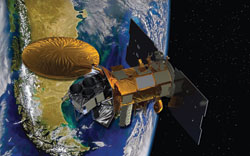
An artist's conception of the Aquarius/SAC-D spacecraft from which NASA is making its first space observations of ocean-surface salinity.
NASA
Anyone who's dunked their head in the ocean knows it's salty, but how salty is it? And how much does that vary? The questions are critical to better understanding Earth's climate, and a GW researcher is working with NASA to find answers within a pinch of salt per gallon of seawater.
The Aquarius/SAC-D spacecraft—a collaboration between NASA and Argentina's space agency—launched into space in June, where the NASA-built Aquarius instrument will observe ocean-surface salinity from 400 miles above the Earth.
"The ocean really governs what happens in the atmosphere, to a large extent," says Roger Lang, a professor in the Department of Electrical and Computer Engineering and a member of NASA's scientific team. Dr. Lang's role has been to perfect a mathematical formula that will allow for the amount of salt to be tabulated within 1/8th of a teaspoon per gallon of ocean water.
Over the scheduled three-year mission, NASA hopes to gain insight into the system of ocean currents, which rely in part on salty waters in order to carry heat from the sun throughout the oceans and regulate climate. The mission also will study the impact of changes to the water cycle—the movement of water through evaporation, precipitation, melting, and freezing—which alters salinity and influences events like monsoons and El Niños.
Ships and buoys at sea have been measuring salinity for 125 years, supplying only limited data. Aquarius will circle the Earth once per week, providing NASA's first space observations of sea surface salinity, and produce global maps charting salinity changes by the month, season, and year.
—Danny Freedman
Keeping Up With Kickbacks
Study of bribe-paying businesses offers glimpse into supply side of corruption.

James Lauritz/Digital Vision/Getty Images
Anti-corruption laws and international conventions are more than legal window dressing. They can serve as deterrents to bribe-paying by businesses.
"For countries that have criminalized foreign bribery on their own or by adopting the international convention, regardless of enforcement activities, their firms were less likely to pay bribes," says Robert J. Weiner, professor of international business, public policy and public administration, and international affairs.
In the report "Who Bribes? Evidence from the United Nations' Oil-for-Food Program," co-authors Dr. Weiner and Yujin Jeong, PhD '10, detailed their study findings that home-country implementation of anti-bribery standards—the Organization for Economic Cooperation and Development's Convention on Combating Bribery of Foreign Public Officials in International Business Transactions—decreased the likelihood of companies engaging in bribery abroad.
The convention, adopted by 38 countries, establishes legally binding standards to criminalize bribery of foreign public officials in conjunction with international business deals.
Dr. Weiner's study looked at data from a forensic investigation completed after the fall of the Iraqi regime under Saddam Hussein. The investigation unearthed details of widespread bribery. "This was truly grand rather than petty corruption," notes Dr. Weiner. "The illicit funds changing hands amounted to well over a billion dollars."
However, the research also concluded that corporate managers from the United States and other signatory countries to the OECD convention were less likely to pay kickbacks.
Dr. Weiner and Dr. Jeong's research, which is slated to appear in Strategic Management Journal, offers a rare examination of the supply side of corruption in a global setting. Most corruption research has focused on bribe takers rather than bribe payers.
By studying who pays bribes, Dr. Weiner hopes to illuminate the decision-making process inside companies. "People have to imagine they're in the shoes of the manager," he says. "In the past, we haven't been able to inform the thinking of MBA students because we haven't looked at bribery from a manager's perspective."
Dr. Weiner also found that private companies were more likely to pay bribes than public corporations. "I thought the type of firm wouldn't make any difference, but it did," he says. "Companies listed on stock exchanges tend to get a lot more scrutiny."
Quality research on corruption is difficult, Dr. Weiner says, because it requires data about activities that happen in the shadows.
"People are much more aware of corruption today than in the past," he says. "How much of that translates into clean and ethical behavior is very hard to know."
—Francis X. Donnelly and Sarah Kellogg
NIH Grant to Fund AIDS Research Center
The National Institutes of Health in July awarded a city-wide consortium, spearheaded by GW, approximately $3 million to establish a Developmental Center for AIDS Research in the nation's capital.
The new District of Columbia D-CFAR will provide scientific leadership and institutional infrastructure to promote HIV/AIDS research, unite researchers from across the city, and foster the next generation of investigators.
The five-year effort is led by Alan E. Greenberg, MD '82, a professor of epidemiology and biostatistics in the School of Public Health and Health Services, and co-director of the GW HIV/AIDS Institute.
At the end of the five-year funding period, the goal is to establish a full CFAR.
$9M Propels Mid-East Studies, Global Security Research
More than $9 million in recent gifts and grants awarded to the Elliott School of International Affairs are broadening and strengthening the school's research in a number of areas, from Middle East studies to global security and international economics.
Earlier this year the university announced that the government of Kuwait had given a gift of $3.5 million as an endowment for GW's Institute for Middle East Studies, which examines the region through a mix of expertise in anthropology, economics, geography, history, language, literature, and politics. The Kuwaiti government also gave $1 million to the Global Resources Center's Middle East and North Africa Research Center, housed at GW's Gelman Library.
An anonymous donor this year made a gift of $3.15 million to support institutional and individual research, courses, events, and conferences sponsored by the Institute for International Economic Policy, Institute for Security and Conflict Studies, and Global Gender Initiative. The gift also provides for four new associate director positions at the Elliott School and supports its Web Video Initiative.
Last year, the school announced nearly $2 million in grant funding from the Carnegie Corporation of New York and the John D. and Catherine T. MacArthur Foundation to lead three cutting-edge international affairs research programs:
- The Rising Powers Initiative, at the Sigur Center for Asian Studies, comprises two main projects: one, supported by the Carnegie Corporation, focuses on tracking the internal foreign policy debates in China, Japan, India, Russia, and Iran; the other, supported by the MacArthur Foundation, examines the likelihood of cooperation or tensions between Asian powers in the foreseeable future.
- The Program on New Approaches to Research and Security in Eurasia, known as PONARS Eurasia, at the Institute for European, Russian and Eurasian Studies, is supported by the Carnegie Corporation. The global network of scholars focuses on issues vital to global security—such as nuclear proliferation, ethnic conflict, terrorism, energy security, economic reform, climate change, and state building—through policy memos and a blog, as well as events and conferences.
- A grant from the Carnegie Corporation also went to support the Institute for Middle East Studies' Project on Middle East Political Science, which aims to build Middle East expertise among U.S. political scientists and increase their impact. The initiative hosts an annual meeting and more regular events delving into timely issues. The project also helps support the Middle East Channel at ForeignPolicy.com, which offers news and analysis.
Supercharging the Fleet
High Performance Computing Lab gets a boost with 1,344-processor core supercomputer.

Meet George: Standing roughly half the size of a vending machine, it's the newest and fastest of the university's supercomputers.
Tarek El-Ghazawi, director of GW's High Performance Computing Lab, shows off his latest acquisition like a muscle car parked in a garage, and with good reason. Under the hood—er, case—the new Cray XE6m supercomputer boasts 1,344 processor cores, capable of crunching 10.6 trillion calculations per second, and 1.9 terabytes of memory.
To put that into perspective, the new supercomputer can complete in a few hours or less tasks that would take weeks on a run-of-the-mill desktop. For example, running a two-nanosecond simulation of how a drug interacts with a virus, known as a molecular dynamic simulation, would take two weeks on a desktop but only a few hours on the Cray. Vehicle crash simulations that once took four days now can be done in 30 minutes.
"This brings to GW the most advanced supercomputing technology available today," says David Dolling, dean of the School of Engineering and Applied Science. "High-performance computing is one of the strategic areas that we are investing in as we move towards becoming a world-class research university."
The computer, which is roughly half the size of a vending machine, is the newest and fastest member of GW's supercomputer fleet. Nicknamed "George," it's packaged with Unified Parallel C, a supercomputer programming language that Dr. El-Ghazawi helped develop. It joined the other computers this summer at the HPC Lab on GW's Virginia Science and Technology Campus, in Ashburn, Va.
Together the computers are used to perform analyses for GW's interdisciplinary Institute for Massively Parallel Applications and Computing Technologies, or IMPACT, for which Dr. El-Ghazawi is founder and director. The Cray also will support the National Science Foundation's Center for High Performance Reconfigurable Computing consortium, co-led by Dr. El-Ghazawi, and the new National Institutes of Health-funded Clinical and Translational Science Institute, a joint institute of the university and Children's National Medical Center.
The $2 million computer was purchased through a $1.2 million National Science Foundation grant and funding from GW's Office of the Executive Vice President for Academic Affairs.
—Carrie Madren
Seeing Through the Static
Researchers devising new method for analyzing security threats.
 When asked about his current research, Nozer Singpurwalla cannot say a whole lot.
When asked about his current research, Nozer Singpurwalla cannot say a whole lot.
"Some of this information is classified, so we can't tell you too much," says Dr. Singpurwalla, a professor of statistics and decision sciences.
He is the lead investigator on a three-year, $776,000 grant from the National Science Foundation and the Defense Threat Reduction Agency, funding the development of new algorithms for assessing national security threats.
Rather than expressing the threat of biological, chemical, or nuclear attacks with qualitative terms like "possible" and "probable," which Dr. Singpurwalla and his colleagues say are not actionable, the project aims to devise a way to express threats as numeric probabilities. Such a system, the researchers say, would enable more decisive actions against threats.
"Our aim is to investigate the mathematical underpinnings of the way threats are analyzed in order to give better probabilities," he says. "We're developing a formal structure under which information from a multitude of sources can be integrated, assessed, and articulated with greater precision."
The team of researchers from Dr. Singpurwalla's Institute for Reliability and Risk Analysis, in the Columbian College of Arts and Sciences, also includes: Refik Soyer, director of the School of Business' interdisciplinary Institute for Integrating Statistics in Decision Sciences; Tapan Nayak, a professor of statistics; Josh Landon, an assistant professor of statistics; and statistics doctoral student Anna Gordon.
The challenge for the researchers lies in classifying information. Threat detection often yields unreliable, incomplete, or vague details, and it can be difficult to differentiate the good from the bad.
"Most of the time, the instruments give you false alarms," says Dr. Singpurwalla, but the risk of not acting upon them is too great.
In analyzing the factors that lead to erroneous findings, and by figuring out how to assess the probabilities of threats, the researchers anticipate their work will have uses in other areas that rely on detection instruments, such as oil exploration, weather prediction, and medical diagnosis.
—Jaclyn Schiff
GSEHD Faculty Takes Top Awards at Annual Meeting
Three faculty members from the Graduate School of Education and Human Development were honored in April at the annual meeting of the American Educational Research Association, or AERA.
The university was represented by a group comprising GSEHD Dean Michael J. Feuer, 30 faculty members, and 24 students that gave more than two dozen presentations.
At the conference, Mary Hatwood Futrell, a former GSEHD dean and current faculty member in the Department of Educational Leadership, was among 31 people selected to become new AERA fellows.
"That's a huge deal," says Sharon Dannels, chair of the department. "Very few people are selected, and it's in recognition of her overall achievements."
Travis Wright, assistant professor of educational research in the Department of Educational Leadership, won the 2011 Early Research Career Award from AERA's Early Education/Child Development Special Interest Group, which is given to an individual with a promising record as a researcher and scholar. Dr. Wright also presented the papers "Goddess: A Portrait of Risk and Resilience in Early Childhood" and "The Politics of Class, Race, Gender, and Geography in Early Childhood Education."
And Jennifer Clayton, assistant professor of educational administration in the Department of Educational Leadership, won the International Journal of Leadership in Education's Emerging Manuscript Award for her work, "Aspiring Educational Leaders and the Internship: Voices from the Field." She also presented "The Evolution of the Intern-Mentor Relationship: Lessons Learned From the Administrative Internship."
The awards offer Dr. Wright and Dr. Clayton recognition "as outstanding researchers by the people in their area," says Dr. Dannels, the department chair. "It's a great honor."
—Carrie Madren
A Home of Its Own
City approves plans for new School of Public Health building on campus.

An artist's conception of the new SPHHS building.
For the first time in its history, the School of Public Health and Health Services will have a place to call its own.
City officials this summer approved the school's plans for a new, more than 115,000-square-foot building across the street from GW Hospital, on Washington Circle at K Street, 24th Street, and New Hampshire Avenue.
The new home of SPHHS—the only school of public health in the nation's capital—will be the first GW building visible to those approaching campus along Pennsylvania Avenue from the west.
The building will serve as a consolidated home for most of the school's faculty, staff, and 1,000 students—a first in the school's 14-year history. The school's seven departments currently are spread across eight locations.
The new building is estimated to cost $75 million and is expected to open during the spring 2014 semester. Current plans call for it to be constructed with a range of sustainable features, and the project will target a minimum of Silver level certification under the U.S. Green Building Council's Leadership in Energy and Environmental Design (LEED) rating system.
The site is currently home to the Warwick Building, which contains various clinical, academic, and administrative programs of the School of Medicine and Health Sciences and GW Hospital.
—GW Today
Blog on a Roll
Professor John Sides and the team behind the blog The Monkey Cage collectively were named 2010 Blogger of the Year by newsmagazine The Week.
The announcement, in May, singled out co-founder Dr. Sides—whose research involves mass political behavior—as the blog's "driving spirit" and lauded the "dogged band of social scientists" who take to the keyboard "whenever the political debate strays too far from the evidence."
The competition's judges called The Monkey Cage (themonkeycage.org) "an invaluable resource not just for academics and political journalists but for all political junkies."
Dr. Sides' collaborators are GW's Henry Farrell, an associate professor of political science and international affairs; Andrew Gelman of Columbia University; Joshua A. Tucker of New York University; and Erik Voeten of Georgetown University.
—GW Today
 The startling estimated prevalence of autism spectrum disorders—equivalent to one in 38—revealed in a study of more than 20,000 children in a South Korean community. Although far more than the U.S. rate of about 1 percent, as estimated by the Centers for Disease Control and Prevention, the study does not suggest Koreans have more autism—only that a more comprehensive search is likely to turn up more cases, says co-author and GW cultural anthropologist Roy Richard Grinker. The study, published in the American Journal of Psychiatry, was based on parent and teacher surveys and diagnostic evaluations, as opposed to studies by the CDC and others that rely on health records and registries.
The startling estimated prevalence of autism spectrum disorders—equivalent to one in 38—revealed in a study of more than 20,000 children in a South Korean community. Although far more than the U.S. rate of about 1 percent, as estimated by the Centers for Disease Control and Prevention, the study does not suggest Koreans have more autism—only that a more comprehensive search is likely to turn up more cases, says co-author and GW cultural anthropologist Roy Richard Grinker. The study, published in the American Journal of Psychiatry, was based on parent and teacher surveys and diagnostic evaluations, as opposed to studies by the CDC and others that rely on health records and registries.
On the Cusp of a New Iron Age
Chemists devise a pollutant-free method for producing iron.
With the dawn of the Iron Age more than 3,000 years ago, the ability to produce and use iron shifted the course of civilization. Now scientists at GW are hoping to create another shift by changing the way iron is made, using a new process that leaves behind no carbon dioxide emissions.
"We've been making iron the same way for millennia and it's just been pumping carbon dioxide into the atmosphere, and it's a huge contributor to greenhouse gases," says GW chemistry professor Stuart Licht. "This looks like a good alternative."
Dr. Licht and co-author Baohui Wang, who worked on the research as a visiting scholar from Northeast Petroleum University, in China, reported last year in the journal Chemical Communications that they found a new path to producing iron through dissolving the two most commonly used types of iron ore—mined rocks that contain iron—in a molten carbon solution, a process previously thought to be impossible, says Dr. Licht.
The researchers then added an electrical current to the molten mix, in a process called electrolysis, to separate the dissolved ore into its two parts, iron and oxygen.
Both sides of the process can be powered by renewable energy—including a new high-efficiency solar technique developed by the researchers and other colleagues—to generate zero carbon dioxide emissions.
Production of iron and steel (an iron-carbon mixture) via smelting currently accounts for a quarter of the world's industrial carbon dioxide emissions, according to the researchers.
The new solar power technique, called the solar thermal electrochemical photo (or STEP) process, is notable for its use of the sun's thermal energy—which Dr. Licht says is usually discarded—in addition to the more commonly used visible light.
Aside from using STEP to power iron production, the researchers have used it to split carbon dioxide into oxygen and either carbon monoxide gas or solid carbon—the latter being "kind of elegant in terms of poetic justice," says Dr. Licht. "We're converting carbon dioxide back to coal, if you will."
Even conversion into carbon monoxide offers a compound that can be mixed with hydrogen to create synthetic diesel and jet fuel.
And where prior attempts at using solar power to capture carbon dioxide have reached efficiencies of only 1 or 2 percent, he says, the efficiency of the STEP processes ranges from 34 percent to more than 50 percent.
More recently, Dr. Licht's lab also has used STEP to efficiently produce bleach, hydrogen, and magnesium and to fuel the desalinization of water.
"I would like us to consider, rather than a fossil fuel economy, a renewable chemical economy," he says.
—Danny Freedman
Revealing a 'More Complex' Neanderthal
Study shows Neanderthals ate and even cooked plants, reshaping thought about their extinction.
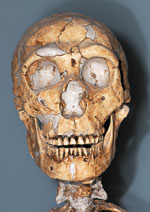
Scott Camazine / Photo Researchers, Inc.
It's a dentist's nightmare. But a lifetime of plaque build-up on the teeth of Neanderthals proved to be a goldmine for a team of researchers whose findings suggest a need to rethink one theory for how these ancient human cousins went extinct.
In a study published in January in the Proceedings of the National Academy of Sciences, researchers from GW and the Smithsonian Institution say their dental digging uncovered plant microfossils and starch granules that indicate Neanderthals consumed a variety of plants, such as palm dates, grains, and legumes—and even cooked some of them, demonstrating a previously unknown level of plant-food preparation for their species. The cooking process can make plants more nutritious and easier to digest.
The findings refute some researchers' speculations that the Neanderthal menu consisted mostly of meat, especially big game, while early modern humans out-competed—and outlived—them thanks to a more diverse diet.
Instead, Neanderthals perhaps "had a little bit more complex dietary behavior than some people had given them credit for," says Amanda Henry, PhD '10, who conducted the research as part of her dissertation work at GW.
"Now that we have this new evidence that they were also consuming plant foods, maybe we need to revisit that theory and try to come up with a slightly more nuanced explanation that better fits the data that we have," she says.
Neanderthals emerged some 200,000 years ago and lived until roughly 28,000 years ago. For part of that time, they co-existed with a handful of other human species, including our own (Homo sapiens).
Dr. Henry conducted her research along with professor Alison Brooks, of GW's Center for the Advanced Study of Hominid Paleobiology, and Dolores Piperno, a GW research professor and scientist with the Smithsonian's National Museum of Natural History, in D.C., and its Tropical Research Institute, in Panama.
—Danny Freedman
Shelf Life
Hot Shops
 Shopaholics aren't the only ones affected by the ascension of the department store into a major urban landmark.
Shopaholics aren't the only ones affected by the ascension of the department store into a major urban landmark.
In fact, department stores have evolved symbiotically with the modern city. Particularly in the first half of the 20th century, myriad influences—including the rise of the car and new paradigms of consumerism—shaped the architectural development of major stores like Marshall Field's and Wanamaker's as surely as they did those stores' home cities of Chicago and Philadelphia.
Richard Longstreth, American studies professor and director of the graduate program in historic preservation, addresses this new lens for viewing metropolitan architecture in his sweeping survey, The American Department Store Transformed: 1920-1960 (Yale University Press, 2010). By examining the architectural changes undergone by major department stores, Dr. Longstreth is able to study complex social issues from a unique perspective.
Take the emergence of the parking lot. The post-World War I boom in car ownership was a mixed blessing. As well-heeled consumers became increasingly inclined to drive and to flock from greater distances, designers were forced to innovate: Potential customers were only useful if they could get out of their cars and shop. The solutions to this problem—from rooftop parking to private garages to valet service—affected, and were affected by, the evolution of the mid-century "downtown."
Sing, Muse, of the Historical Record
 Homer's Iliad is a cornerstone of Western literature: The affair of Trojan prince Paris and married Greek beauty Helen, and its devastating consequences, have inspired artists from Shakespeare to Brad Pitt. The Trojan epic also has an enduring power over the imaginations of scholars and archaeologists, who have in modern times invested much in determining Troy's historical antecedents.
Homer's Iliad is a cornerstone of Western literature: The affair of Trojan prince Paris and married Greek beauty Helen, and its devastating consequences, have inspired artists from Shakespeare to Brad Pitt. The Trojan epic also has an enduring power over the imaginations of scholars and archaeologists, who have in modern times invested much in determining Troy's historical antecedents.
At Hisarlik, a site in western Turkey, many believe it has been found. In Digging for Troy: From Homer to Hisarlik (Charlesbridge, 2011), Eric H. Cline, chair of the Department of Classical and Near Eastern Languages and Civilizations, co-writing with Jill Rubalcaba, tells the story of the parade of eccentrics and intellectuals who have sought Homer's Troy there.
Dr. Cline and Dr. Rubalcaba focus on the quest to determine whether the Trojan War as Homer described it ever actually occurred—and, if it did, whether Hisarlik might have been its site.
The people seeking Troy's remains there have been as varied, and as controversial, as their theories. Nineteenth-century entrepreneur Heinrich Schliemann, the first character the authors discuss, plowed carelessly through layers of artifacts and ruins, kept imperfect records, and twisted his findings to suit his predetermined narrative.
But he also made discoveries on which later, more proficient expeditions could build. Archaeologist Carl Blegen was able to refine Hisarlik's layers of structure into a timeline of nine Trojan settlements, one of which he believed showed signs of a devastating siege. Modern expeditions, like those led by German archaeologist Manfred Korfmann, have been more ambivalent about the idea of a historical Trojan War. But all of these Hisarlik explorers are bound by their inability to resist the allure of the Homeric epic.
—Ruth Steinhardt
$20 Million Grant Focuses on Fighting Childhood Diseases
A joint institute of GW and Children's National Medical Center has been awarded $20 million by the National Institutes of Health to help speed the transition of scientific discoveries into new therapies and health care policies.
The July announcement of the five-year grant to the Clinical and Translational Science Institute, housed at Children's National, marked the first time the NIH's Clinical and Translational Science Award had been given directly to a children's hospital.
Translational science refers to the process of translating findings from the laboratory into treatments that can be useful to patients and have an impact on broader communities.
The institute joins a nationally renowned consortium of research centers that have won CTSA funding from the NIH's National Center for Research Resources.
The collaborative institute has three main areas of focus: childhood diseases (such as cancer and birth defects); childhood diseases that persist into adulthood (such as congenital heart disease and muscular dystrophy); and adult diseases that begin in childhood and worsen or develop with age (such as hypertension and type 2 diabetes).
The grant money, along with contributions from both sides, will allow the university and Children's National to more effectively leverage resources and expertise that are linked through the grant consortium.
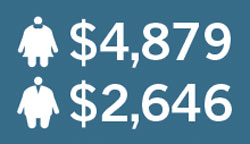 The annual individual cost of obesity for women and men in the United States, according to a report last year by researchers in the Department of Health Policy. The costs were far lower for people who are overweight, rather than obese—$524 for women, $432 for men. But if trends hold, the researchers say, half the U.S. population could be obese by 2030.
The annual individual cost of obesity for women and men in the United States, according to a report last year by researchers in the Department of Health Policy. The costs were far lower for people who are overweight, rather than obese—$524 for women, $432 for men. But if trends hold, the researchers say, half the U.S. population could be obese by 2030.
GW Listed Among Top Research Schools
GW was one of 14 schools added this year to a prestigious list of higher education institutions with "very high research activity." The new categorization appears in the 2010 update to the Carnegie Classification of Institutions of Higher Education, released in January by the independent Carnegie Foundation for the Advancement of Teaching.
A three-tiered research university category—topped by the "very high research activity" label—in 2005 replaced the well-known categories "Research I & II." The top tier now lists 108 institutions.
"It's clear that the word has gone out that our aspirations are to be a premier research institution, and we have attracted some substantial grants that have made the news," says GW Vice President for Research Leo Chalupa.
"This is a good thing," he says, "but with respect to our research accomplishments, I always like to say, the best is yet to come."
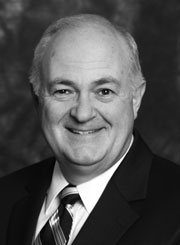
GW President Steven Knapp
Honorable Mentions
Several members of the GW faculty and administration this year were recognized with top honors in their fields.
The American Academy of Arts and Sciences elected into its ranks GW President Steven Knapp, a specialist in Romanticism, literary theory, and the relation of literature to philosophy and religion, as well as professor Martha Finnemore, whose prize-winning research focuses on global governance, international organizations, ethics, and social theory.
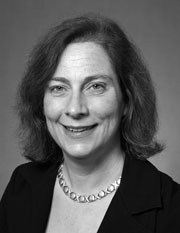
Martha Finnemore, professor of political science and international affairsThe organization, founded in 1780 by John Adams and other scholar-patriots, has counted as members George Washington, Benjamin Franklin, Daniel Webster, Ralph Waldo Emerson, Albert Einstein, and Winston Churchill. Today the group includes some 250 Nobel laureates and more than 60 Pulitzer Prize winners.
Among other faculty awards, Michael Plesniak, chair of the Department of Mechanical and Aerospace Engineering, was named a fellow of the American Association for the Advancement of Science for his work in fluid dynamics; Jeffrey J. Cohen, a professor of English and human sciences, was selected as a 2011 Guggenheim Fellow by the John Simon Guggenheim Memorial Foundation, one of the most esteemed awards in the humanities; and the 2011 IZA Prize in Labor Economics was awarded to Barry R. Chiswick, chair of the economics department, for his fundamental contributions to the economic analysis of migration.
Driving Innovation
Software for auto dealers nabs $25K top prize in annual business plan contest.
The $25,000 top prize in this year's GW Business Plan Competition was awarded to a start-up that provides customized brochures for potential car buyers and is already operating at five dealerships in Kansas City, Mo. The team beat out a record 112 teams to win the April contest.
The start-up, Lead Driver—composed of MBA student Anthony Shop, alumnus David Raffel, B.A.'76, Daniel Zaslavsky, and Thomas Sanchez—uses a web-based software called DealerPrints to create brochures tailored to the dealership, the car, and the customer. Sales staff enter details about a customer's needs and a personalized brochure is generated with the aim of shortening the sale cycle.
The team plans to use its winnings to implement Lead Driver in 24 dealerships in Kansas City, Mo., and Chicago.
Business Plan Competition Director John Rollins, an adjunct professor of entrepreneurship, says the multidisciplinary make-up of the team—representing experience in auto dealerships, software, and business school—ultimately helped it prevail over the competition.
"That kind of balance makes a big difference when you're starting a business," he says.
The three runner-ups—Bookstore Genie, Leafworks, and Ascend Air— received $10,000, $4,000, and $1,000, respectively. Undergraduate Farhan Daredia of Bookstore Genie, a company that sells textbooks online at the cheapest price, also won $10,000 for "best undergraduate team."
Leafworks sells disposable dinnerware made of leaves, and Ascend Air is a skyship that helps executives in Virginia avoid traffic during their commute.
The competition is funded by Florida Gov. Richard Scott and his wife, Annette, entrepreneurs whose daughter Allison Guimard, BBA '05, also is an entrepreneur. Additional sponsors this year included Blank Rome, iStrategyLabs, and Tech Cocktail.
The contest finals are the culmination of a yearlong series of educational events and mentorship for the teams—support that winner Mr. Shop says was crucial to Lead Driver's overall success.
"We made tremendous progress that we'd never have made if we weren't part of this competition. Winning is great and
is icing on the cake," he says, "but we've come so much further along just because we participated."
—GW Today




 When asked about his current research, Nozer Singpurwalla cannot say a whole lot.
When asked about his current research, Nozer Singpurwalla cannot say a whole lot. 
 The startling estimated prevalence of autism spectrum disorders—equivalent to one in 38—revealed in a study of more than 20,000 children in a South Korean community. Although far more than the U.S. rate of about 1 percent, as estimated by the Centers for Disease Control and Prevention, the study does not suggest Koreans have more autism—only that a more comprehensive search is likely to turn up more cases, says co-author and GW cultural anthropologist Roy Richard Grinker. The study, published in the American Journal of Psychiatry, was based on parent and teacher surveys and diagnostic evaluations, as opposed to studies by the CDC and others that rely on health records and registries.
The startling estimated prevalence of autism spectrum disorders—equivalent to one in 38—revealed in a study of more than 20,000 children in a South Korean community. Although far more than the U.S. rate of about 1 percent, as estimated by the Centers for Disease Control and Prevention, the study does not suggest Koreans have more autism—only that a more comprehensive search is likely to turn up more cases, says co-author and GW cultural anthropologist Roy Richard Grinker. The study, published in the American Journal of Psychiatry, was based on parent and teacher surveys and diagnostic evaluations, as opposed to studies by the CDC and others that rely on health records and registries.
 Shopaholics aren't the only ones affected by the ascension of the department store into a major urban landmark.
Shopaholics aren't the only ones affected by the ascension of the department store into a major urban landmark. Homer's Iliad is a cornerstone of Western literature: The affair of Trojan prince Paris and married Greek beauty Helen, and its devastating consequences, have inspired artists from Shakespeare to Brad Pitt. The Trojan epic also has an enduring power over the imaginations of scholars and archaeologists, who have in modern times invested much in determining Troy's historical antecedents.
Homer's Iliad is a cornerstone of Western literature: The affair of Trojan prince Paris and married Greek beauty Helen, and its devastating consequences, have inspired artists from Shakespeare to Brad Pitt. The Trojan epic also has an enduring power over the imaginations of scholars and archaeologists, who have in modern times invested much in determining Troy's historical antecedents. The annual individual cost of obesity for women and men in the United States, according to a report last year by researchers in the Department of Health Policy. The costs were far lower for people who are overweight, rather than obese—$524 for women, $432 for men. But if trends hold, the researchers say, half the U.S. population could be obese by 2030.
The annual individual cost of obesity for women and men in the United States, according to a report last year by researchers in the Department of Health Policy. The costs were far lower for people who are overweight, rather than obese—$524 for women, $432 for men. But if trends hold, the researchers say, half the U.S. population could be obese by 2030.
